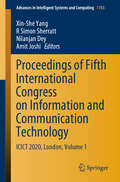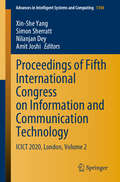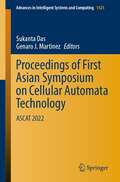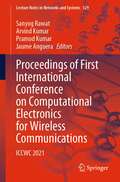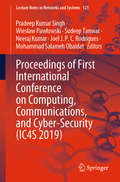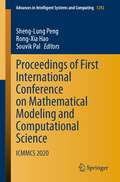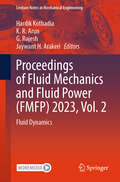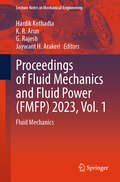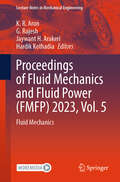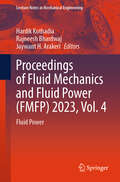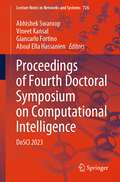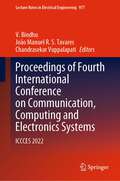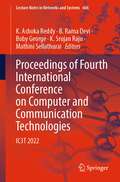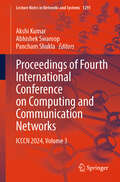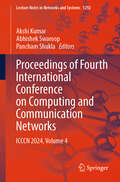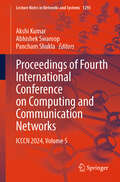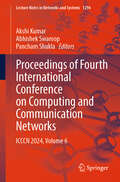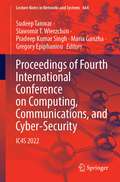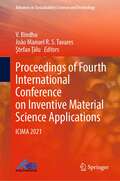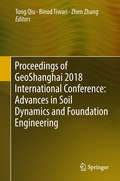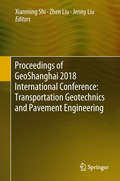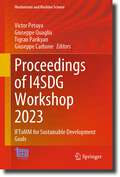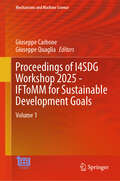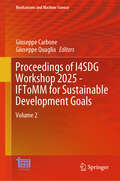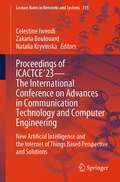- Table View
- List View
Proceedings of Fifth International Congress on Information and Communication Technology: ICICT 2020, London, Volume 1 (Advances in Intelligent Systems and Computing #1183)
by Xin-She Yang Nilanjan Dey Amit Joshi R Simon SherrattThis book gathers selected high-quality research papers presented at the Fifth International Congress on Information and Communication Technology, held at Brunel University, London, on February 20–21, 2020. It discusses emerging topics pertaining to information and communication technology (ICT) for managerial applications, e-governance, e-agriculture, e-education and computing technologies, the Internet of Things (IoT) and e-mining. Written by respected experts and researchers working on ICT, the book offers a valuable asset for young researchers involved in advanced studies.
Proceedings of Fifth International Congress on Information and Communication Technology: ICICT 2020, London, Volume 2 (Advances in Intelligent Systems and Computing #1184)
by Xin-She Yang Nilanjan Dey Amit Joshi Simon SherrattThis book gathers selected high-quality research papers presented at the Fifth International Congress on Information and Communication Technology, held at Brunel University, London, on February 20–21, 2020. It discusses emerging topics pertaining to information and communication technology (ICT) for managerial applications, e-governance, e-agriculture, e-education and computing technologies, the Internet of Things (IoT) and e-mining. Written by respected experts and researchers working on ICT, the book offers a valuable asset for young researchers involved in advanced studies.
Proceedings of First Asian Symposium on Cellular Automata Technology: ASCAT 2022 (Advances in Intelligent Systems and Computing #1425)
by Sukanta Das Genaro J. MartinezThis book gathers selected research papers presented at the First Asian Symposium on Cellular Automata Technology (ASCAT 2022), organized online by academicians from Kolkata, India, during March 3–5, 2022. The book presents one of the most emergent areas in natural computing, cellular automaton (CA). CA is a paradigm of uniform fine-grained parallel computation which has been explored to understand complex systems by developing its model at the microscopic level. The book discusses many real-life problems in the domain of very large-scale integration (VLSI) design and test, pattern recognition and classification, cryptography, pseudo-random pattern generation, image processing, sensor networks, material science, etc., by using CA.
Proceedings of First International Conference on Computational Electronics for Wireless Communications: ICCWC 2021 (Lecture Notes in Networks and Systems #329)
by Pramod Kumar Arvind Kumar Jaume Anguera Sanyog RawatThis book includes high-quality papers presented at Proceedings of First International Conference on Computational Electronics for Wireless Communications (ICCWC 2021), held at National Institute of Technology, Kurukshetra, Haryana, India, during June 11–12, 2021. The book presents original research work of academics and industry professionals to exchange their knowledge of the state-of-the-art research and development in computational electronics with an emphasis on wireless communications. The topics covered in the book are radio frequency and microwave, signal processing, microelectronics and wireless networks.
Proceedings of First International Conference on Computing, Communications, and Cyber-Security (Lecture Notes in Networks and Systems #121)
by Neeraj Kumar Pradeep Kumar Singh Sudeep Tanwar Wiesław Pawłowski Joel J. P. C. Rodrigues Mohammad Salameh ObaidatThis book features selected research papers presented at the First International Conference on Computing, Communications, and Cyber-Security (IC4S 2019), organized by Northwest Group of Institutions, Punjab, India, Southern Federal University, Russia, and IAC Educational Trust, India along with KEC, Ghaziabad and ITS, College Ghaziabad as an academic partner and held on 12–13 October 2019. It includes innovative work from researchers, leading innovators and professionals in the area of communication and network technologies, advanced computing technologies, data analytics and intelligent learning, the latest electrical and electronics trends, and security and privacy issues.
Proceedings of First International Conference on Mathematical Modeling and Computational Science: ICMMCS 2020 (Advances in Intelligent Systems and Computing #1292)
by Sheng-Lung Peng Souvik Pal Rong-Xia HaoThis book presents the most recent scientific and technological advances in the fields of engineering mathematics and computational science, to strengthen the links in the scientific community. It is a collection of high-quality, peer-reviewed research papers presented at the First International Conference on Mathematical Modeling and Computational Science (ICMMCS 2020), held in Pattaya, Thailand, during 14–15 August 2020. The topics covered in the book are mathematical logic and foundations, numerical analysis, neural networks, fuzzy set theory, coding theory, higher algebra, number theory, graph theory and combinatory, computation in complex networks, calculus, differential educations and integration, application of soft computing, knowledge engineering, machine learning, artificial intelligence, big data and data analytics, high-performance computing, network and device security, and Internet of things (IoT).
Proceedings of Fluid Mechanics and Fluid Power: Fluid Dynamics (Lecture Notes in Mechanical Engineering)
by G. Rajesh Hardik Kothadia K. R. Arun Jaywant H. ArakeriThis book presents select proceedings of the 10th International and 50th National Conference on Fluid Mechanics and Fluid Power. It covers recent research developments in the area of fluid mechanics, measurement techniques in fluid flows, and computational fluid dynamics. The key research topics discussed in this book are fundamental studies in flow instability and transition, fluid-structure interaction, multiphase flows, solidification, melting, cavitation, porous media flows, bubble and droplet dynamics, bio-mems, micro-scale experimental techniques, flow control devices, underwater vehicles, bluff body, bio-fluid mechanics, aerodynamics, turbomachinery, propulsion and power, heat transfer and thermal engineering, fluids engineering, advances in aerospace and defence technology, micro- and nano-systems engineering, acoustics, structures and fluids, advanced theory and simulations, novel experimental techniques in thermo-fluids engineering and many more. The book is a valuable reference for researchers and professionals interested in thermo-fluids engineering.
Proceedings of Fluid Mechanics and Fluid Power: Fluid Mechanics (Lecture Notes in Mechanical Engineering)
by G. Rajesh Hardik Kothadia K. R. Arun Jaywant H. ArakeriThis book presents select proceedings of the 10th International and 50th National Conference on Fluid Mechanics and Fluid Power. It covers recent research developments in the area of fluid mechanics, measurement techniques in fluid flows, and computational fluid dynamics. The key research topics discussed in this book are fundamental studies in flow instability and transition, fluid-structure interaction, multiphase flows, solidification, melting, cavitation, porous media flows, bubble and droplet dynamics, bio-MEMS, micro-scale experimental techniques, flow control devices, underwater vehicles, bluff body, bio-fluid mechanics, aerodynamics, turbomachinery, propulsion and power, heat transfer and thermal engineering, fluids engineering, advances in aerospace and defence technology, micro- and nano-systems engineering, acoustics, structures and fluids, advanced theory and simulations, novel experimental techniques in thermofluids engineering, and many more. The book is a valuable reference for researchers and professionals interested in thermo-fluids engineering.
Proceedings of Fluid Mechanics and Fluid Power: Fluid Mechanics (Lecture Notes in Mechanical Engineering)
by G. Rajesh Hardik Kothadia K. R. Arun Jaywant H. ArakeriThis book presents select proceedings of the 10th International and 50th National Conference on Fluid Mechanics and Fluid Power. It covers recent research developments in the area of fluid mechanics, measurement techniques in fluid flows, computational fluid dynamics. The key research topics discussed in this book are fundamental studies in flow instability and transition, fluid-structure interaction, multiphase flows, solidification, melting, cavitation, porous media flows, bubble and droplet dynamics, bio-mems, micro-scale experimental techniques, flow control devices, underwater vehicles, bluff body, bio-fluid mechanics, aerodynamics, turbomachinery, propulsion and power, heat transfer and thermal engineering, fluids engineering, advances in aerospace and defence technology, micro- and nano-systems engineering, acoustics, structures and fluids, advanced theory and simulations, novel experimental techniques in thermo-fluids engineering, and many more. The book is a valuable reference for researchers and professionals interested in thermo-fluids engineering.
Proceedings of Fluid Mechanics and Fluid Power: Fluid Power (Lecture Notes in Mechanical Engineering)
by Hardik Kothadia Jaywant H. Arakeri Rajneesh BhardwajThis book presents select proceedings of the 10th International and 50th National Conference on Fluid Mechanics and Fluid Power. It covers recent research developments in the area of fluid mechanics, measurement techniques in fluid flows, computational fluid dynamics. The key research topics discussed in this book are fundamental studies in flow instability and transition, fluid-structure interaction, multiphase flows, solidification, melting, cavitation, porous media flows, bubble and droplet dynamics, bio-mems, micro-scale experimental techniques, flow control devices, underwater vehicles, bluff body, bio-fluid mechanics, aerodynamics, turbomachinery, propulsion and power, heat transfer and thermal engineering, fluids engineering, advances in aerospace and defense technology, micro- and nano-systems engineering, acoustics, structures and fluids, advanced theory and simulations, novel experimental techniques in thermofluids engineering, and many more. The book is a valuable reference for researchers and professionals interested in thermo-fluids engineering.
Proceedings of Fourth Doctoral Symposium on Computational Intelligence: DoSCI 2023 (Lecture Notes in Networks and Systems #726)
by Giancarlo Fortino Aboul Ella Hassanien Abhishek Swaroop Vineet KansalThis book features high-quality research papers presented at Fourth Doctoral Symposium on Computational Intelligence (DoSCI 2023), organized by Institute of Engineering and Technology (IET), AKTU, Lucknow, India, on March 3, 2023. This book discusses the topics such as computational intelligence, artificial intelligence, deep learning, evolutionary algorithms, swarm intelligence, fuzzy sets and vague sets, rough set theoretic approaches, quantum-inspired computational intelligence, hybrid computational intelligence, machine learning, computer vision, soft computing, distributed computing, parallel and grid computing, cloud computing, high-performance computing, biomedical computing, and decision support and decision making
Proceedings of Fourth International Conference on Communication, Computing and Electronics Systems: ICCCES 2022 (Lecture Notes in Electrical Engineering #977)
by João Manuel R. S. Tavares Chandrasekar Vuppalapati V. BindhuThis book includes high-quality research papers presented at the Fourth International Conference on Communication, Computing and Electronics Systems (ICCCES 2022), held at the PPG Institute of Technology, Coimbatore, India, on September 15–16, 2022. The book focuses mainly on the research trends in cloud computing, mobile computing, artificial intelligence and advanced electronics systems. The topics covered are automation, VLSI, embedded systems, optical communication, RF communication, microwave engineering, artificial intelligence, deep learning, pattern recognition, communication networks, Internet of things, cyber-physical systems and healthcare informatics.
Proceedings of Fourth International Conference on Computer and Communication Technologies: IC3T 2022 (Lecture Notes in Networks and Systems #606)
by K. Srujan Raju Boby George Mathini Sellathurai K. Ashoka Reddy B. Rama DeviThe book is a compilation of high-quality scientific papers presented at the 4th International Conference on Computer & Communication Technologies (IC3T 2022). The book covers cutting-edge technologies and applications of soft computing, artificial intelligence and communication. In addition, a variety of further topics are discussed, which include data mining, machine intelligence, fuzzy computing, sensor networks, signal and image processing, human-computer interaction, and web intelligence.
Proceedings of Fourth International Conference on Computing and Communication Networks: ICCCN 2024, Volume 3 (Lecture Notes in Networks and Systems #1291)
by Akshi Kumar Abhishek Swaroop Pancham ShuklaThis book includes selected peer-reviewed papers presented at fourth International Conference on Computing and Communication Networks (ICCCN 2024), held at Manchester Metropolitan University, UK, during 17–18 October 2024. The book covers topics of network and computing technologies, artificial intelligence and machine learning, security and privacy, communication systems, cyber physical systems, data analytics, cyber security for industry 4.0, and smart and sustainable environmental systems.
Proceedings of Fourth International Conference on Computing and Communication Networks: ICCCN 2024, Volume 4 (Lecture Notes in Networks and Systems #1292)
by Akshi Kumar Abhishek Swaroop Pancham ShuklaThis book includes selected peer-reviewed papers presented at fourth International Conference on Computing and Communication Networks (ICCCN 2024), held at Manchester Metropolitan University, UK, during 17–18 October 2024. The book covers topics of network and computing technologies, artificial intelligence and machine learning, security and privacy, communication systems, cyber physical systems, data analytics, cyber security for industry 4.0, and smart and sustainable environmental systems.
Proceedings of Fourth International Conference on Computing and Communication Networks: ICCCN 2024, Volume 5 (Lecture Notes in Networks and Systems #1293)
by Akshi Kumar Abhishek Swaroop Pancham ShuklaThis book includes selected peer-reviewed papers presented at fourth International Conference on Computing and Communication Networks (ICCCN 2024), held at Manchester Metropolitan University, UK, during 17–18 October 2024. The book covers topics of network and computing technologies, artificial intelligence and machine learning, security and privacy, communication systems, cyber physical systems, data analytics, cyber security for industry 4.0, and smart and sustainable environmental systems.
Proceedings of Fourth International Conference on Computing and Communication Networks: ICCCN 2024, Volume 6 (Lecture Notes in Networks and Systems #1294)
by Akshi Kumar Abhishek Swaroop Pancham ShuklaThis book includes selected peer-reviewed papers presented at fourth International Conference on Computing and Communication Networks (ICCCN 2024), held at Manchester Metropolitan University, UK, during 17–18 October 2024. The book covers topics of network and computing technologies, artificial intelligence and machine learning, security and privacy, communication systems, cyber physical systems, data analytics, cyber security for industry 4.0, and smart and sustainable environmental systems.
Proceedings of Fourth International Conference on Computing, Communications, and Cyber-Security: IC4S 2022 (Lecture Notes in Networks and Systems #664)
by Pradeep Kumar Singh Gregory Epiphaniou Sudeep Tanwar Maria Ganzha Slawomir T. WierzchonThis book features selected research papers presented at the Fourth International Conference on Computing, Communications, and Cyber-Security (IC4S 2022), organized in Ghaziabad India, during October 21–22, 2022. The conference was hosted at KEC Ghaziabad in collaboration with WSG Poland, SFU Russia, & CSRL India. It includes innovative work from researchers, leading innovators, and professionals in the area of communication and network technologies, advanced computing technologies, data analytics and intelligent learning, the latest electrical and electronics trends, and security and privacy issues.
Proceedings of Fourth International Conference on Inventive Material Science Applications: ICIMA 2021 (Advances in Sustainability Science and Technology)
by João Manuel R. S. Tavares V. Bindhu Ştefan ŢăluThe volume is a collection of best selected research papers presented at the 4th International Conference on Inventive Material Science Applications (ICIMA 2021) organized by PPG Institute of Technology, Coimbatore, India during 14 – 15 May 2021. The book includes original research by material science researchers towards developing a compact and efficient functional elements and structures for micro, nano and optoelectronic applications. The book covers important topics like nanomaterials and devices, optoelectronics, sustainable electronic materials, nanocomposites and nanostructures, hybrid electronic materials, medical electronics, computational material science, wearable electronic devices and models, and optical/nano-sensors.
Proceedings of GeoShanghai 2018 International Conference: Advances in Soil Dynamics and Foundation Engineering
by Zhen Zhang Binod Tiwari Tong QiuThis book is the sixth volume of the proceedings of the 4th GeoShanghai International Conference that was held on May 27 - 30, 2018. This volume, entitled “Advances in Soil Dynamics and Foundation Engineering”, covers the recent advances and technologies in soil dynamics and foundation engineering. These papers are grouped into four categories: (1) soil dynamics and earthquake engineering, (2) deep excavations and retaining structures, (3) shafts and deep foundations, and (4) offshore geotechnics. It presents the state-of-the-art theories, experiments, methodologies and findings in the related areas. The book may benefit researchers and scientists from the academic fields of soil dynamics and earthquake engineering, geotechnical engineering, geoenvironmental engineering, transportation engineering, geology, mining and energy, as well as practical engineers from the industry. Each of the papers included in this book received at least two positive peer reviews. The editors would like to express their sincerest appreciation to all of the anonymous reviewers all over the world, for their diligent work.
Proceedings of GeoShanghai 2018 International Conference: Transportation Geotechnics and Pavement Engineering
by Zhen Liu Xianming Shi Jenny LiuThis book is the fourth volume of the proceedings of the 4th GeoShanghai International Conference that was held on May 27 - 30, 2018. This volume, entitled “Transportation Geotechnics and Pavement Engineering”, represents the recent advances and technologies in transportation geotechnics and pavement engineering. This book covers a wide range of topics, from transportation geotechnics, to geomechanics at various length scales, to pavement materials and structures. The book offers a unique mix of numerical modeling studies, experimental studies, and case studies from industry. It may be of interest to researchers and practitioners in the fields of transportation engineering and pavement engineering.Each of the papers included in this book received at least two positive peer reviews. The editors would like to express their sincerest appreciation to all of the anonymous reviewers all over the world, for their diligent work.
Proceedings of I4SDG Workshop 2023: IFToMM for Sustainable Development Goals (Mechanisms and Machine Science #134)
by Giuseppe Carbone Victor Petuya Giuseppe Quaglia Tigran ParikyanThis volume contains the proceedings of the 2nd IFToMM Workshop for Sustainable Development Goals - I4SDG 2023 held in Bilbao, Spain, on 22-23 June 2023. The workshop papers are focused on those aspects of the theory, design and applications of Mechanism and Machine Science that are fundamental for moving towards sustainable development. The main topics of the workshop are: sustainable energy systems, robotics and mechatronics, biomechanical and medical systems, education, linkages, gears, transmissions and actuators, engines and powertrains, tribology, transportation machinery, service systems for sustainability, humanitarian engineering and socio-technical systems for sustainable and inclusive development. The contributions, selected through a rigorous international peer-review process, highlight many exciting ideas that will drive new research directions and foster multidisciplinary collaboration between researchers from different backgrounds.
Proceedings of I4SDG Workshop 2025 - IFToMM for Sustainable Development Goals: Volume 1 (Mechanisms and Machine Science #179)
by Giuseppe Carbone Giuseppe QuagliaThis book contains the proceedings of the 3rd IFToMM Workshop for Sustainable Development Goals (I4SDG), held in Lamezia Terme, Italy, on June 9–11, 2025. The workshop papers are focused on those aspects of the theory, design, and applications of mechanism and machine science that are fundamental for moving toward sustainable development. The main topics of the workshop are: sustainable energy systems, robotics and mechatronics, biomechanical and medical systems, education, linkages, gears, transmissions and actuators, engines and powertrains, tribology, transportation machinery, service systems for sustainability, humanitarian engineering, and socio-technical systems for sustainable and inclusive development. The contributions, selected through a rigorous international peer-review process, highlight many exciting ideas that will drive new research directions and foster multidisciplinary collaboration between researchers from different backgrounds.
Proceedings of I4SDG Workshop 2025 - IFToMM for Sustainable Development Goals: Volume 2 (Mechanisms and Machine Science #180)
by Giuseppe Carbone Giuseppe QuagliaThis book contains the proceedings of the 3rd IFToMM Workshop for Sustainable Development Goals (I4SDG), held in Lamezia Terme, Italy, on June 9–11, 2025. The workshop papers are focused on those aspects of the theory, design, and applications of mechanism and machine science that are fundamental for moving toward sustainable development. The main topics of the workshop are: sustainable energy systems, robotics and mechatronics, biomechanical and medical systems, education, linkages, gears, transmissions and actuators, engines and powertrains, tribology, transportation machinery, service systems for sustainability, humanitarian engineering, and socio-technical systems for sustainable and inclusive development. The contributions, selected through a rigorous international peer-review process, highlight many exciting ideas that will drive new research directions and foster multidisciplinary collaboration between researchers from different backgrounds.
Proceedings of ICACTCE'23 — The International Conference on Advances in Communication Technology and Computer Engineering: New Artificial Intelligence and the Internet of Things Based Perspective and Solutions (Lecture Notes in Networks and Systems #735)
by Natalia Kryvinska Zakaria Boulouard Celestine IwendiToday, communication technology and computer engineering are intertwined, with advances in one field driving advances in the other, leading to the development of outstanding technologies. This book delves into the latest trends and breakthroughs in the areas of communication, Internet of things, cloud computing, big data, artificial intelligence, and machine learning.This book discusses challenges and opportunities that arise with the integration of communication technology and computer engineering. In addition, the book examines the ethical and social implications, including issues related to privacy, security, and digital divide and law. We have explored the future direction of these fields and the potential for further breakthroughs and innovations.The book is intended for a broad audience of undergraduate and graduate students, practicing engineers, and readers without a technical background who have an interest in learning about communication technology and computer engineering.
